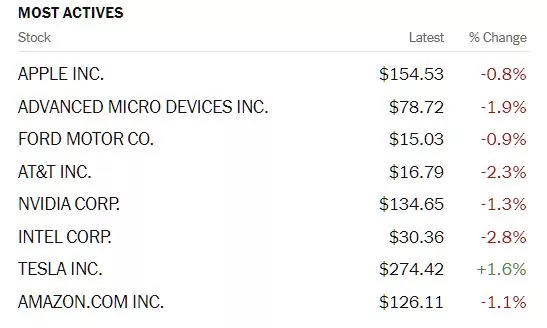Words For Wednesday: Gravity And The Dollar
While stocks continue to feel the gravitational pull of the Earth, risk-off sentiment is taking the dollar higher toward the Sun. Yesterday's back to work bustle was not enough to end Wall Street's current losing streak.

At the close of trading on Tuesday the S&P 500 was down 16 points to close at 3,908, the Dow lost 173 points to close at 31,145 and the Nasdaq Composite shed 86 points closing at 11,545.
Most actives all closed in the red, except for Tesla (TSLA) which was up 1.6%.

Chart: The New York Times
Morning sentiment at the moment can be described as numb. S&P market futures are trading up 4 points, Dow market futures are trading up 20 points and Nasdaq 100 market futures are trading up 19 points.
TalkMarkets contributor Michael Kramer writes Stocks Drop On September 6 As Financial Conditions Tightening More.
"Stocks were up sharply at the open, but that faded quickly, with the S&P 500 finishing the day down by roughly 40 bps to close at 3,908. The declines followed a better-than-expected August ISM services reading that showed GDP is growing at an annualized pace of 2.5%. The news sent yields and the dollar soaring, allowing financial conditions to tighten further.
Today’s battle for the S&P 500 was between 3,900 and 3,920. Right now, the index is just consolidating and is likely to drop to around 3,820 over the near term to fill the gap at that level. You can see the symmetrical triangle, a consolidation pattern that typically resolves in the direction of the prior trend or down."

Contributor Declan Fallon says Russell 2000 Suffers Heaviest Loss As Selling Continues.
"Friday's selling continued into Tuesday, with the Russell 2000 experiencing the worst of the losses. Indices are fast running out of support with Fibonacci retracements under threat after today's losses; this has become most apparent in the Nasdaq but no index is safe. The Russell 2000 is looking the most vulnerable as today's bearish candlestick has the look of a continuation move.
The selling in the Russell 2000 has only just delivered a loss of stochastic midline support which adds to the pressure on bulls and means we are looking at a return to the bear market phase which has dominated throughout 2022. "

Central Banks seeking to tame inflation across continents take the dollar higher as contributors Francesco Pesole, Frantisek Taborsky and Chris Turner find in FX Daily: 75bp Hike Seen In Canada, 25bp Hike Expected In Poland.
"We expect the Bank of Canada to hike by 75bp and to maintain a hawkish tone for future tightening. In Poland, we see risks of a dovish surprise, as the NBP may only hike by 25bp and sound less hawkish after recent data. Elsewhere, good ISM data has reinforced Fed pricing and the dollar's momentum, while the risk of JPY intervention is rising significantly.
The dollar has remained bid since the start of the week and was bolstered yesterday by a surprise rise (albeit marginal) in the US ISM service index. Our economist thinks yesterday’s figures endorse our 3%+ 3Q GDP forecast for the US. A solid growth story is indeed a key source of momentum for the dollar rally as markets feel increasingly confident with their pricing for more aggressive Fed tightening. A 75bp hike in September is almost fully priced in now (69bp are embedded into the swap market), but barring any big data disappointment, the room for any dovish re-pricing appears limited at this stage.
The sharp underperformance of the Chinese yuan and Japanese yen has continued to fuel dollar strength too. This morning, a miss in Chinese trade data sent USD/CNY to test 9.9800, erasing efforts by the People's Bank of China to support the yuan. It remains to be seen how much Chinese authorities see 7.00 as a pivotal level."
Unsplash
TM contributor Sarah Fenwick notes Sentiment Primed For ECB Interest Rate Decision, Fed Speeches.
"After nearly three-quarters of volatility triggered by high inflation and geopolitical pressures, it seems that market sentiment is primed for a jump in interest rates in the Eurozone ahead of the European Central Bank’s (ECB) monetary policy meeting.
The ECB meets on Thursday, September 8, and is expected to raise its key interest rate from 0.5 percent to 1 percent. The Eurozone’s inflation rate reached a record high of 9.1 percent in August, increasing the risks of entrenched high prices weighing on consumer spending power.
With the EUR (FXE) at multi-decade lows against the USD, the bloc’s single currency may be at a disadvantage during trades for goods and services, but the EU’s exports have been rising steadily since April. Exports from the EU increased from 22.1 billion in May to 22.5 billion in June, reflecting a five-year high. This contributes to overall economic growth and cash flow as Europe struggles with the fallout from the war in Ukraine."
The Staff at JustForex reports that Asian markets were down as well on Tuesday, while China Reported A Falling Trade Balance.
"Asian markets traded flat yesterday. Japan's Nikkei 225 (JP225) gained 0.03% yesterday, Hong Kong's Hang Seng (HK50) ended yesterday down 0.12%, and Australia's S&P/ASX 200 (AU200) fell by 0.38% yesterday.
Australia's annual GDP at the end of July was 3.6% instead of the expected 3.4%. Quarterly GDP grew by 0.9% from the previous value of +0.8%. Australian stock index ASX 200 gained slightly on this news.
China's trade balance for August was 535.91 billion yuan, compared to the expected 504.85 billion yuan, and 682.69 billion yuan last year. Exports jumped by 11.8% last month against an expected 15.7%. The country's imports grew by 4.6% against the expected 8.7%. Markets treated the data as negative as exports and imports missed expectations."

Jill Mislinski finds more signs of U.S. economic strength in the ISM Services Report: Incremental Growth In August.
"The Institute of Supply Management (ISM) has now released the August Services Purchasing Managers' Index (PMI). The headline Composite Index is at 56.9 percent and is up 0.2 from 56.7 last month. Today's number came in above the Investing.com forecast of 55.1 percent.
Here is the report summary:
(Tempe, Arizona) — Economic activity in the services sector grew in August for the 27th month in a row — with the Services PMI® registering 56.9 percent — say the nation's purchasing and supply executives in the latest Services ISM® Report On Business®.
The report was issued today by Anthony Nieves, CPSM, C.P.M., A.P.P., CFPM, Chair of the Institute for Supply Management® (ISM®) Services Business Survey Committee: “In August, the Services PMI® registered 56.9 percent, 0.2 percentage point higher than July’s reading of 56.7 percent. The Business Activity Index registered 60.9 percent, an increase of 1 percentage point compared to the reading of 59.9 percent in July. The New Orders Index figure of 61.8 percent is 1.9 percentage points higher than the July reading of 59.9 percent...The services sector had a slight uptick in growth for the month of August due to increases in business activity, new orders and employment. Based on comments from Business Survey Committee respondents, there are some supply chain, logistics and cost improvements; however, material shortages remain a challenge. Employment improved slightly despite a restricted labor market.”
Manufacturing may be a more sensitive barometer than Non-Manufacturing activity, but we are increasingly a services-oriented economy, which explains our intention to keep this series on the radar.
Here is a table showing the trend in the underlying components."

Contributor Lance Roberts closes out the column today with a note on earnings estimates on the Street in an Editor's Choice column titled, Earnings Decline, Likely More To Go Before We Are Done.
"With the Fed hiking rates, high inflation, and slower economic growth pending, a continuation of an earnings decline remains highly probable.
We previously noted that earnings estimates were overly optimistic and would need to come down to align with economic realities. That process has now begun. In the last couple of months, estimates for Q4-2023 have dropped by roughly 12%. Such would be considered normal for an economic slowdown. However, if the economy slips into a recession, a decline of 50% in estimates would be in line."
![]()
"There should be no surprise, given that economic growth and earnings have a long-term historical correlation. Such would seem logical, given that economic activity generates revenues for companies. Therefore, while it is possible for earnings to grow faster than the economy at times, i.e., post-recession, they can not outgrow the economy indefinitely. The earnings surge in 2021 is something never witnessed previously and must eventually revert to norms...
While many have become increasingly bullish on the market, suggesting the “bottom” for stocks gets made, I would caution otherwise.
The market risk remains fundamentals against a backdrop of the reversal of monetary accommodation. The most significant bottom-line earnings drivers remain accounting gimmicks, share repurchases, and lower tax rates. However, as we advance, there are numerous risks to earnings."
See Roberts full article for additional charts and observations.
Caveat Emptor.
More By This Author:
TalkMarkets Image Library
Thoughts For Thursday: On The Downward Trail
Tuesday Talk: Back In The Same Place




